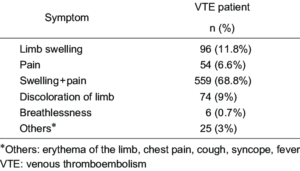Signs and Symptoms
Some common signs and symptoms of Deep vein thrombosis are as follows [1]
- Swelling
- Pain
- Flushing and a feeling of warmth in the involved area
- Soreness in veins
DVT may sometimes occur without any symptoms. Particular signs are neither distinctive nor sensitive to DVT. Trauma, sepsis, peripheral vascular disease, as well as other vein disorders, can all manifest clinically as DVT.
Shortness of breath, chest discomfort, trouble breathing, fainting, and wheezing are the most typical symptoms and indicators of pulmonary embolism. Temperature, hemoptysis, discoloration of the limb, low blood pressure, and convulsions are less frequent signs and indications. Furthermore, many individuals have concurrent DVT symptoms and signs. In individuals who already have dyspnea, severe dyspnea could be the only sign of pulmonary embolism. DVT can also occur with any of the above diseases [2].

Figure 1 Signs and symptoms in VTE patients [3]
When to see a doctor?
You have read about the different signs and symptoms of Deep Vein Thrombosis. And based on these symptoms, you must visit a doctor as soon as possible whenever you think the patient may have it. Especially if you are having trouble breathing and at the same time have redness on the leg skin and pain underneath it, then definitely visit your general physician. Never wait it out because it may lead to further complications.
References
- Galanaud, J.-P. and S.R. Kahn, Postthrombotic syndrome: a 2014 update. Current opinion in cardiology, 2014. 29(6): p. 514-519.
- Kahn, S.R., et al., Determinants and time course of the postthrombotic syndrome after acute deep venous thrombosis. Annals of internal medicine, 2008. 149(10): p. 698-707.
- Basavanthappa, R., et al., RAVS Study: One Indian Single Center Analysis of Patients with VTE. Annals of Vascular Diseases, 2019. 12.

